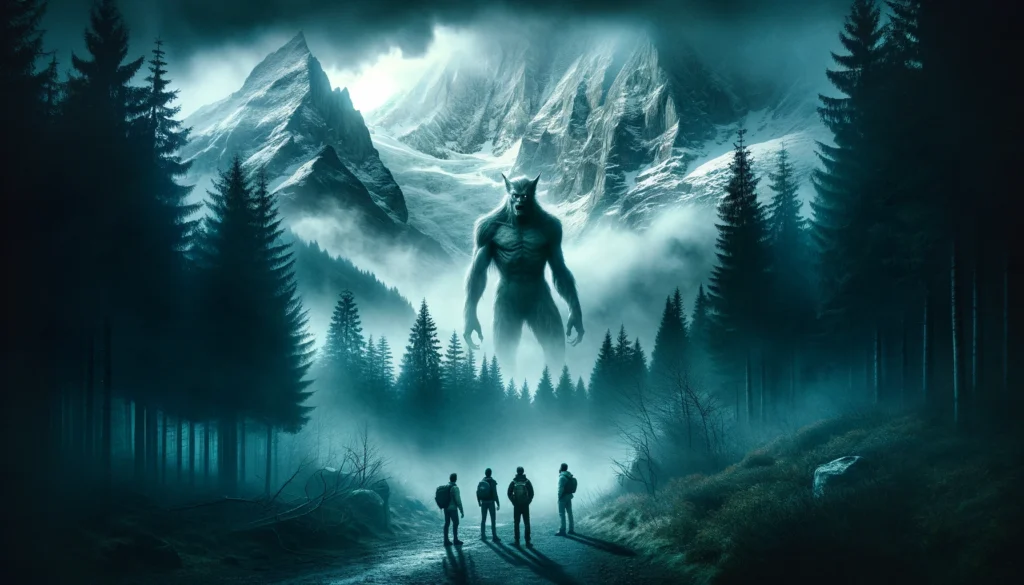Werewolves have been a part of human folklore for centuries. These mythical creatures have been the subject of many movies, books, and TV shows. But the question remains: do werewolves actually exist?
According to legend, werewolves are humans who can transform into wolves or wolf-like creatures during the full moon. Some believe that these transformations are caused by a curse or a bite from another werewolf. While there is no scientific evidence to support the existence of werewolves, there have been many reported sightings and encounters over the years.
Despite the lack of concrete evidence, the idea of werewolves continues to captivate the public imagination. Many people are drawn to the idea of shape-shifting and the power that comes with it. Others are fascinated by the idea of a hidden world of creatures that exist just beyond our understanding. In this article, we will explore the question of whether werewolves are real and examine the evidence for and against their existence.
Historical Beliefs
Werewolves have been a subject of fascination and fear for centuries. While there is no scientific evidence to support their existence, many cultures have believed in their existence based on ancient legends, medieval accounts, and modern interpretations.
Ancient Legends
The idea of humans turning into wolves is not a new concept. Ancient legends from various cultures, including Greek, Norse, and Native American, have stories of shapeshifters. In Greek mythology, the god Zeus transformed King Lycaon into a wolf as punishment for his cruelty. In Norse mythology, the berserkers were warriors who could transform into wolves or bears during battle.

Medieval Accounts
During the Middle Ages, werewolf trials were common in Europe. People accused of being werewolves were often tortured and executed. In some cases, people believed they had been cursed by a witch or had made a deal with the devil. The werewolf trials eventually died out, but the belief in werewolves persisted in folklore.
Modern Interpretations
In modern times, werewolves have become a popular subject in literature and film. While some people still believe in their existence, the scientific community does not recognize them as a real phenomenon. Some scientists suggest that the belief in werewolves may have been based on medical conditions such as hypertrichosis, which causes excessive hair growth, or porphyria, a rare genetic disorder that can cause sensitivity to sunlight.
In conclusion, the belief in werewolves has been a part of human culture for centuries. While there is no scientific evidence to support their existence, the stories and legends surrounding werewolves continue to captivate people’s imaginations.
Cultural Impact
Literature Influence
Werewolves have been a popular subject in literature for centuries. One of the earliest examples of werewolf tales can be found in Greek mythology. The legend of Lycaon, a king who was turned into a wolf by the gods as punishment for his cruelty, has been told for generations. In modern times, werewolves have been featured in numerous books and series, including the Twilight Saga and the Harry Potter series. These stories have helped to keep the myth of werewolves alive in popular culture.
Film and Television
Werewolves have also been a popular subject in film and television. One of the most iconic werewolf movies is “An American Werewolf in London,” which was released in 1981. Since then, werewolves have been featured in countless movies and TV shows, including “Teen Wolf,” “Underworld,” and “The Howling.” These depictions have helped to shape the image of werewolves in popular culture.
Folklore and Mythology
Werewolves have been a part of folklore and mythology for centuries. In many cultures, werewolves were believed to be shape-shifting humans who could turn into wolves or wolf-like creatures. In some cases, werewolves were seen as protectors or guardians, while in others they were feared and reviled. These stories have helped to keep the myth of werewolves alive throughout history.
Overall, the cultural impact of werewolves cannot be denied. From ancient mythology to modern literature and film, werewolves have captured the imaginations of people around the world. While the question of whether werewolves exist in reality remains unanswered, their place in popular culture is secure.
Scientific Perspective
Genetic Anomalies
From a genetic perspective, werewolves are considered to be a myth. There is no scientific evidence to suggest that humans can transform into wolves or any other animal. While there are genetic anomalies that can result in excessive hair growth or other physical abnormalities, there is no evidence to suggest that these conditions can lead to a transformation into a werewolf.
Psychological Explanations
There are some psychological explanations for the belief in werewolves. Some people may suffer from a condition known as clinical lycanthropy, which is a rare psychiatric disorder that causes individuals to believe that they can transform into animals. However, this is a very rare condition and is not considered to be evidence of the existence of werewolves.
Cryptozoology
Cryptozoology is the study of animals that are rumored to exist, but for which there is no scientific evidence. While some people believe in the existence of werewolves, there is no scientific evidence to support this belief. Many of the stories about werewolves can be traced back to folklore and mythology, rather than any real evidence.
In conclusion, from a scientific perspective, there is no evidence to suggest that werewolves exist. While there are genetic anomalies and psychological conditions that can lead to beliefs in werewolves, there is no scientific evidence to support the idea that humans can transform into animals.
Eyewitness Accounts
Contemporary Sightings
In recent years, there have been several reported sightings of werewolves around the world. These sightings are often described as large, humanoid creatures with fur, claws, and sharp teeth. One notable sighting occurred in 2016, when a group of hikers in the French Alps reported seeing a creature that they believed to be a werewolf. The creature was described as standing over seven feet tall, with broad shoulders and a muscular build.

Another contemporary sighting took place in 2018 in the forests of Wisconsin, USA. A hunter reported seeing a large, wolf-like creature walking on two legs. The creature reportedly had glowing eyes and emitted a low growl before disappearing into the woods.
Historical Reports
Werewolf sightings have been reported throughout history, with some of the earliest accounts dating back to ancient Greece and Rome. One famous historical report comes from the 16th century, when a Frenchman named Gilles Garnier was accused of being a werewolf. Garnier was said to have transformed into a wolf-like creature and killed several children before being caught and executed.
In the 18th century, a German farmer named Peter Stubbe was also accused of being a werewolf. Stubbe was said to have made a deal with the devil, which gave him the ability to transform into a wolf and commit gruesome murders. He was eventually caught and executed, and his case became one of the most well-known werewolf trials in history.
While these historical reports cannot be confirmed, they provide insight into the longstanding belief in werewolves and the fear they have instilled in people throughout the ages.
Skepticism and Debunking
Logical Analysis
Many people are skeptical about the existence of werewolves due to the lack of logical analysis. The transformation of a human into a wolf-like creature is not biologically possible, as the genetic makeup of humans and wolves are vastly different. Additionally, the idea of a full moon causing this transformation is also illogical, as the moon does not have any known physical effects on humans.
Lack of Evidence
Another reason for skepticism is the lack of evidence supporting the existence of werewolves. Despite numerous claims and legends, there has been no concrete scientific evidence to prove the existence of these creatures. Many supposed sightings and encounters can be explained by other natural phenomena or simply as hoaxes.
In conclusion, skepticism and debunking are important in the study of werewolves. Without logical analysis and evidence, the existence of these creatures remains a topic of myth and legend rather than scientific fact.
Social Phenomena
Mass Hysteria
Throughout history, there have been instances of mass hysteria where a group of people believed they had witnessed or experienced a supernatural event. In some cases, this has been attributed to the belief in werewolves. For example, in the late 16th century, the French town of Bedburg was gripped by fear after several people were allegedly killed by a werewolf. This led to a mass hysteria where many people claimed to have seen the creature, and several innocent people were executed for being werewolves.
Another example of mass hysteria occurred in the early 20th century in the town of Hull, England. Several people claimed to have seen a werewolf-like creature, and this led to a wave of panic and fear in the town. However, upon further investigation, it was discovered that the sightings were likely due to a large dog that had escaped from a local circus.
Urban Legends
Werewolves have also become a popular subject in urban legends. These stories often involve a person who transforms into a werewolf under certain circumstances, such as during a full moon. While these stories may be entertaining, there is no scientific evidence to support the existence of werewolves.
One famous urban legend involves the Beast of Bray Road, a werewolf-like creature that was allegedly sighted in Wisconsin during the 1990s. Despite numerous sightings and investigations, no concrete evidence was ever found to support the existence of the creature.
Overall, while werewolves may be a popular subject in folklore and popular culture, there is no scientific evidence to suggest that they actually exist. The social phenomena surrounding werewolves, such as mass hysteria and urban legends, are more likely due to human imagination and cultural beliefs.
Frequently Asked Questions
What is the origin of werewolf legends?
Werewolf legends date back to ancient times and are found in many cultures around the world. The Greeks, Romans, and Norse all had their own versions of werewolf mythology, and the belief in werewolves persisted throughout the Middle Ages.
Are there any historical accounts of werewolves?
There are many historical accounts of people claiming to be werewolves or being accused of being werewolves. These accounts range from the 16th century to modern times and come from all over the world.
How does one supposedly become a werewolf?
According to myth, there are many ways to become a werewolf. Some say that it is a curse passed down through generations, while others believe that it can be acquired through a bite or scratch from another werewolf.
Can werewolves reproduce with humans according to myth?
In some versions of werewolf mythology, it is said that werewolves can mate with humans and produce offspring. However, this is not a universal belief and varies depending on the culture and tradition.
What evidence exists regarding the reality of werewolves?
There is no scientific evidence to support the existence of werewolves. While there are many historical accounts and myths surrounding werewolves, there is no concrete proof of their existence.
What are the most common attributes of werewolves in folklore?
Werewolves are often depicted as having superhuman strength, heightened senses, and the ability to transform from human to wolf form. They are also said to be vulnerable to silver and to be able to only transform during a full moon.






